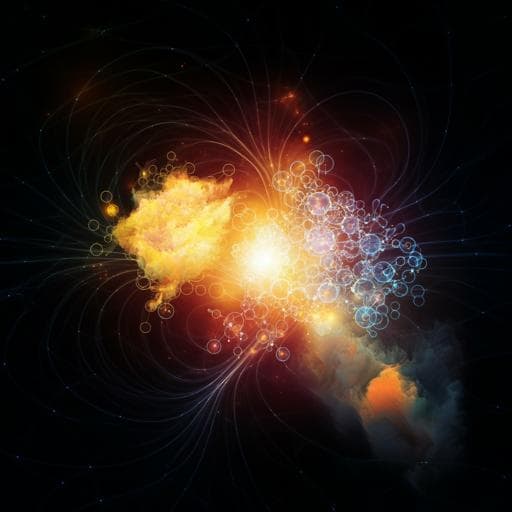
Psychology
Concept and location neurons in the human brain provide the ‘what’ and ‘where’ in memory formation
S. Mackay, T. P. Reber, et al.
This groundbreaking study explores the neuronal mechanisms of memory formation, revealing distinct neuron populations that encode what we experience and where it happens. Conducted by Sina Mackay, Thomas P. Reber, Marcel Bausch, Jan Boström, Christian E. Elger, and Florian Mormann, this research uncovers how our brains remember and spatially navigate different experiences.
~3 min • Beginner • English
Introduction
The medial temporal lobe (MTL) is central to episodic memory, which integrates information about what happened, where, and when. Although population-level activity in the human MTL has been linked to successful memory encoding, the neuron-level mechanisms that convert perception into enduring memories remain poorly understood. Prior work identified domain-specific representations in the MTL, including hippocampal place cells, entorhinal grid cells, and neurons whose activity relates to temporal structure, suggesting a framework in which spatial and temporal codes support episodic memory. Human studies have also revealed “concept cells” that respond invariantly to semantic content across formats and modalities. The present study asks whether selective single neurons in human MTL exhibit subsequent memory effects during associative encoding of item–location pairs, thereby elucidating how “what” (concept) and “where” (location) information are represented and linked during memory formation.
Literature Review
Extensive animal and human literature supports spatial and temporal coding in MTL: hippocampal place cells and entorhinal grid cells provide spatial maps; neurons modulated by elapsed time suggest parallel coding of space and time. Models (e.g., Buzsáki & Tingley) propose the hippocampus as a sequence generator rather than domain-specific, aligning with parallels between place and time cells. Human imaging and MEG studies show grid-like representations in EC during navigation; single-neuron studies in humans and non-human primates reveal entorhinal cells tuned to visual-space or target locations, though human EC may not be broadly scene-selective. Parahippocampal cortex (PHC) is consistently implicated in spatial navigation, scene processing, and both allocentric and egocentric spatial representations. Concept cells—visually and semantically selective neurons—have been reported in hippocampus, amygdala, and EC, responding invariantly to people, objects, and names, and even during imagery and recall. Prior neuronal studies of human memory often found subsequent memory effects at the population level but inconsistent effects at the level of selective single neurons, with exceptions for certain egocentric spatial cells. These strands motivate testing whether concept-like item cells and spatially tuned location cells show encoding-related modulation predictive of later memory.
Methodology
Participants: Thirteen in-patients (20–62 years; 8F/5M) with drug-resistant epilepsy undergoing invasive monitoring with bilaterally implanted depth electrodes (amygdala, hippocampus, EC, PHC; standard scheme) participated with informed consent and IRB approval (University of Bonn). They performed tasks on a touchscreen laptop while seated in bed.
Screening: A same-day screening identified response-eliciting images using either an object screening (100 common objects/animals, each repeated 10 times; task: man-made?) or a personalized screening (100–150 images of familiar persons/places/objects, each repeated 6 times; task: contains a face?), enabling detection of significant item responses across a broad semantic space.
Main task: Associative encoding of item–location pairs within a 3×3 on-screen grid. During encoding, images appeared one at a time at random grid locations; participants confirmed location by tapping within the presentation window (typically 1.5–3.5 s, adaptively adjusted to target ~50% accuracy). Invalid trials (missed or off-target taps) were excluded. After encoding, a 15-s backward-counting distractor (count down by 3s) minimized rehearsal. Retrieval presented each item beneath an empty grid; participants indicated the remembered location via touch. Difficulty was titrated by adaptively adjusting presentation duration (step 0.5 s; reset to 2 s after set-size changes) and set size (increased after consecutive high performance; decreased after consecutive low performance). Sessions lasted up to 35 min; mean trials/session ≈ 187 (range 64–278); mean set size ≈ 3.2 (range 1–7).
Electrophysiology: Recordings used microwire bundles (8 recording + 1 reference wire per bundle) protruding ~4 mm from clinical macroelectrodes. Signals were sampled at 32 kHz (Neuralynx ATLAS). Spike detection/sorting (CombinatoR) included automated artifact rejection and manual curation, classifying single units (SU) and multi-units (MU). Signal-to-noise ratio (SNR) was computed (mean spike amplitude / median absolute signal); SUs had significantly higher SNR than MUs (median SNR 2.85, P < 10^-8, rank-sum).
Responsiveness and statistics: Item responsiveness was determined via binwise rank-sum tests (100 ms windows, 50% overlap, 0–1000 ms post-stimulus) using alpha = 0.001. Fractions of responsive neurons per region were assessed with binomial tests (P0 = 0.001) and permutation tests with 10,000 label shuffles to estimate empirical size. Location responsiveness required significant responses to one or more of the nine grid locations. Population activity was analyzed via cluster-based permutation tests comparing subsequently remembered vs. forgotten trials over time (paired tests at each time point; clusters compared against 10,000 label-shuffled iterations; top 5% cluster sizes deemed significant).
Behavioral-performance modeling: Linear mixed-effects models related subsequent memory to experimental parameters (set size, trial duration, reaction time), with fixed effects for condition and random intercepts/slopes for patient and session (session nested within patient). Estimates reported as fixed slopes (β).
Delay-period analysis: During the 15-s counting delay between encoding and retrieval, firing rates of neurons selective for exactly one stimulus were normalized to pre-encoding baselines, and compared between subsequently remembered vs. forgotten episodes (paired t-tests per region and overall).
Control analyses: Main effects were re-tested excluding neurons classified as both item and location responsive; first vs. second half of trials tested for adaptation/interference; retrieval-phase selectivity verified by higher firing to preferred vs. non-preferred items (and preferred locations in PHC) using signed-rank tests on firing rates in the 1000 ms before the retrieval response.
Key Findings
- Task/difficulty effects: Subsequent memory related to set size (β = -0.27, P < 10^-6); forgotten trials occurred in larger sets.
- Item-selective neurons: Significant fractions of item-responsive neurons were detected across amygdala, hippocampus, EC, and PHC (binomial, all P < 10^-4; empirical alpha < 10^-4 across regions). Item responses showed robust subsequent memory effects in amygdala (latency 239–1249 ms), hippocampus (531–796 ms), and EC (491–618 ms), with higher firing during subsequently remembered trials. No significant item-memory modulation was observed in PHC.
- Location-selective neurons: Significant fractions of location-responsive neurons were found by nominal binomial tests in amygdala, hippocampus, and PHC (all P < 10^-20), but permutation tests indicated only PHC had a significant empirical size (PHC empirical size = 0.0027; amygdala = 0.23; hippocampus = 0.81). In PHC, approximately 80% of neurons responded to at least one grid square, a higher fraction than in amygdala or hippocampus (chi-square, both P < 10^-3).
- Subsequent memory effects in location cells: PHC location neurons exhibited higher firing for subsequently remembered trials in a later window (1059–1444 ms), partially overlapping but later than item effects; this effect persisted when aligned to the motor response (post-tap 25–506 ms), arguing against motor confounds.
- Effect sizes in non-selective populations: Small subsequent memory effects were seen in neurons without significant item/location selectivity in amygdala (d = 0.10, P = 0.046, pre-stimulus) and EC (d = 0.14 or 0.23, P ≈ 0.031, pre-stimulus), markedly smaller than the effects in selective populations (d ≈ 0.21–0.30). PHC non-selective activity showed negative effect sizes in some alignments (e.g., d = -0.60, P < 0.001).
- Delay period: No significant reactivation differences during the 15-s counting delay between remembered vs. forgotten episodes overall (t(19) = -0.68, P = 0.50) or within regions (all P > 0.1); PHC location vs. non-location comparisons also non-significant (t(26) = -0.21, P = 0.84).
- Controls: Excluding neurons classified as both item and location selective did not change main effects; no substantial adaptation/interference across trial halves; retrieval-phase firing remained higher for preferred items in all regions (all P < 0.001) and for preferred locations in PHC (P < 0.001), supporting genuine selectivity.
Discussion
Results demonstrate that sparse, selective neuronal populations in the human MTL carry predictive signals for successful encoding of item–location associations. Concept-like item neurons in amygdala, hippocampus, and EC exhibited higher firing during encoding when items were later correctly placed, supporting the role of concept cells as building blocks of memory and aligning with hippocampal indexing theory: selective neurons may serve as pointers to neocortical content representations. In contrast, location-selective neurons were prominent in PHC and showed later subsequent memory effects, suggesting PHC provides spatial (“where”) information via a neocortical population code rather than acting as an index. The later timing of location memory effects relative to item effects may reflect processing hierarchy wherein “what/who” information is prioritized over spatial context, consistent with thematic hierarchies of semantic prominence and behavioral observations that objects are processed or communicated before spatial relations. EC activity patterns resembled amygdala/hippocampus more than PHC in this task, potentially because the paradigm emphasized allocentric map-like spatial processing rather than egocentric navigation, a context in which EC spatial tuning is often stronger. Overall, the findings integrate well with indexing frameworks: hippocampal (and amygdala/EC) concept neurons could coordinate with PHC spatial representations to bind the elements of episodic memories.
Conclusion
The study identifies two specialized neuronal populations supporting episodic memory formation in humans: concept-selective item neurons in hippocampus, amygdala, and entorhinal cortex that predict successful encoding of “what/who,” and parahippocampal location-selective neurons that encode “where,” showing later subsequent memory effects. These results provide single-neuron evidence consistent with hippocampal indexing, where selective neurons may serve as pointers to distributed neocortical representations, while PHC likely implements spatial representations via population coding. Future work should test these mechanisms in tasks requiring egocentric navigation, probe causal relationships and interactions between item and location codes, and examine consolidation dynamics and cross-regional coordination (e.g., phase-locking, replay) that might strengthen index–content associations over time.
Limitations
- The study was not designed to investigate memory consolidation; rehearsal was minimized and analyses focused on encoding and immediate retrieval.
- Entorhinal spatial tuning was weak in this paradigm, potentially due to the lack of egocentric navigation demands; thus, findings about EC spatial coding may not generalize to navigation-rich contexts.
- Participants were epilepsy patients with intracranial electrodes, which may limit generalizability to the broader population.
- The spatial task used a constrained 3×3 grid on a touchscreen, emphasizing allocentric mapping; different spatial demands might yield different regional contributions.
Related Publications
Explore these studies to deepen your understanding of the subject.







